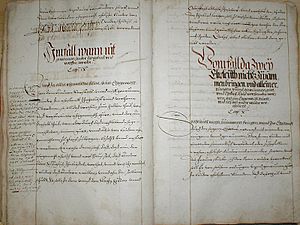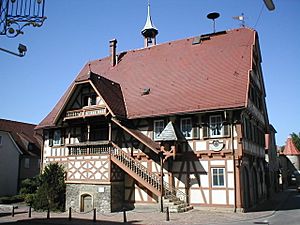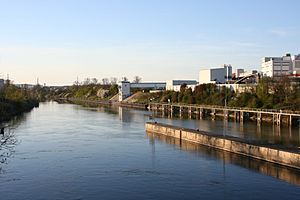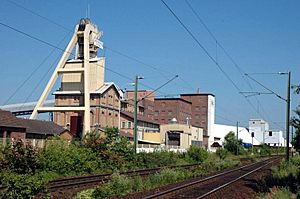Bad Friedrichshall facts for kids
Quick facts for kids
Bad Friedrichshall
|
||
|---|---|---|

Kochendorf castle
|
||
|
||
| Country | Germany | |
| State | Baden-Württemberg | |
| Admin. region | Stuttgart | |
| District | Heilbronn | |
| Elevation | 167 m (548 ft) | |
| Population
(2022-12-31)
|
||
| • Total | 19,962 | |
| Time zone | CET/CEST (UTC+1/+2) | |
| Postal codes |
74177
|
|
| Dialling codes | 07136 | |
| Vehicle registration | HN | |
Bad Friedrichshall is a town in southern Germany. It is in the Heilbronn district of Baden-Württemberg. The town is special because it sits where two rivers, the Jagst and the Kocher, flow into the Neckar River. It is about 10 kilometers (6 miles) north of the city of Heilbronn. Bad Friedrichshall was formed in 1933 when the villages of Kochendorf and Jagstfeld joined together. The town is well-known for its salt mine.
Contents
Geography of Bad Friedrichshall
Bad Friedrichshall is located in the Heilbronn district in the state of Baden-Württemberg, in southern Germany. Its location at the meeting point of the Jagst, Kocher, and Neckar rivers is very important.
Nearby Towns and Villages
Bad Friedrichshall is surrounded by several towns and villages. These include Neckarsulm, Untereisesheim, Bad Wimpfen, Offenau, Gundelsheim, Neudenau, Neuenstadt am Kocher, and Oedheim. All these places are part of the Heilbronn district. Bad Friedrichshall also works closely with Oedheim and Offenau on local government matters.
Parts of the Town
Bad Friedrichshall is made up of several smaller areas. These are the villages of Kochendorf, Jagstfeld, Hagenbach, Duttenberg, Untergriesheim, and Plattenwald. A small settlement called Heuchlingen is part of Duttenberg. Other small areas, Waldau and Hasenmühle, used to be part of Hagenbach but are now part of Kochendorf.
History of Bad Friedrichshall
Bad Friedrichshall was created in 1933. This happened when the villages of Kochendorf and Jagstfeld combined. The name Friedrichshall comes from a salt-works in Jagstfeld. This salt-works was named after Frederick I of Württemberg in 1818. The word Hall is often used in this area for places connected to the salt industry.
Kochendorf Village
The village of Kochendorf started as a settled estate around 817. It is located on a hill where the Kocher and Neckar rivers meet. The St. Sebastian church likely existed even before 1100. Around 1200, Kochendorf was surrounded by a brick wall. In the 13th century, a noble family from Kochendorf was first mentioned. They were connected to the Staufer family in Wimpfen.
In the 15th and 16th centuries, these noble families built three castles. In 1672, the Freiherrs of Saint-André bought part of the village. They built a new castle on one of the old castle sites. In 1762, a group called Ritterkanton Odenwald bought the entire village. Kochendorf became their main office.
In 1806, Kochendorf became a free municipality within Württemberg. In 1899, a salt factory called Salzwerke Heilbronn AG opened there.
From the 16th to the 19th century, a large Jewish community lived in Kochendorf. A synagogue was built around 1740, and a new one in 1806. By 1854, the community grew to 154 people. This was almost 9% of the village's population. However, many people later moved away. By 1880, only 71 Jewish residents remained. By 1925, there were only 7 Jews left. The Jewish community ended before 1933. They sold their synagogue to the Protestant church. Sadly, five of Kochendorf's last seven Jewish residents died due to persecution between 1940 and 1943.
From 1933 to 1945
In 1933, Kochendorf joined with Jagstfeld to form Bad Friedrichshall. Two years later, Hagenbach also became part of the town.
During World War II, in September 1944, a special work camp was set up in Kochendorf. This camp was connected to a larger camp called Natzweiler-Struthof. Companies like Hochtief AG helped build production facilities in the salt mine. The aircraft company Ernst Heinkel AG used the mine to build experimental parts for airplane engines. Other companies like Robert Bosch GmbH and Siemens-Schuckert-Werke AG made spark plugs and electrical parts. Motorenwerke Mannheim AG built submarine engine parts in the mine.
Today, you can visit a detailed exhibition about this time. It is located in the Bad Friedrichshall Kochendorf salt mine.
From 1945 to Today
On June 17, 1951, Bad Friedrichshall officially became a town. Later, on March 15, 1972, Duttenberg joined the town. On January 1, 1975, Untergriesheim also became part of Bad Friedrichshall.
From 1992 to 1998, a new housing area called Plattenwald was built. This was part of a state program to provide homes for new residents.
Culture and Sights
Interesting Buildings
- The Lehen Castle in Kochendorf was built in 1533. It was made in the Renaissance style. Today, it is used as a hotel.
- The Greckenschloss in Kochendorf was built in 1602. It has been used for many different things since 1806. For a while, it was a factory for cigars and drinks. Since 2010, after being fixed up, it is now an elementary school. It also has rooms for the local music school and a painting school for children.
- The St. Andre Castle was built in 1710. Today, a notary's office is located in this building.
- The old town hall of Kochendorf was built in 1597. It has a special half-timbered style. It used to have a covered market on the ground floor. It also served as an office for a knightly group. Later, it was a police station.
- The Protestant Sebastianskirche is likely the oldest building in Kochendorf. It probably existed before 1100. The church was first mentioned in 1294. It had many valuable old items. Sadly, it was destroyed in World War II.
- The old wine press of Kochendorf was built in 1553. Since 1920, it has been used as a gym. It is also a place for events at the Lehen Castle.
- Wendelinus Tower is in Jagstfeld.
- Heuchlingen Castle in Duttenberg is part of a large farm area.
- The old town hall of Hagenbach was built around 1800. It replaced an older castle.
- The cemetery chapel in Hagenbach dates back to the 16th century.
- The salt mine Bad Friedrichshall in Kochendorf is still working. It is a popular place for visitors from all over. You can visit it on weekends.
Regular Events
- Kilianimarkt: This is a market held every year at the beginning of July.
- Wald- und Bockbierfest: This is a celebration held every year. It takes place on the last weekend of July and the first weekend of August.
Economy and Infrastructure
Transport
Bad Friedrichshall-Jagstfeld was once a very important railway hub. It was a border station between two regions, Baden and Württemberg, from 1869 to 1920. The large train yard shows how important it once was.
At Bad Friedrichshall-Jagstfeld station, several train lines meet. The Elsenz Valley Railway and the Neckar Valley Railway connect with the Franconia Railway. The Franconia Railway goes from Stuttgart to Würzburg. There was also a line to Ohrnberg until 1993.
Kochendorf and Untergriesheim have other train stations on the Franconia Railway. Only local trains stop there. Another station, Duttenberg-Obergriesheim, closed in 1971.
The local public transport is managed by the Heilbronner Hohenloher Haller Nahverkehr (HNV).
The main road, B 27, goes through the town. This road connects to the larger highway, Bundesautobahn 6.
Local Businesses
The Südwestdeutsche Salzwerke AG (SWS) operated the Kochendorf salt mine from 1899 to 1994. In 1901, the main shaft was named after William II. Until 1984, the mine only had one shaft. Then, a 3.7-kilometer (2.3-mile) long underground tunnel was built. This tunnel connected it to another factory in Heilbronn. It was also built to help workers leave safely in an emergency. Since 1994, parts of the mine have been filled. However, a special visitor's mine is still open. It has a large underground hall from the 1920s.
The company Richard Hengstenberg GmbH & Co. KG makes canned foods in Kochendorf. The company Hänel Büro- und Lagersysteme started in 1953. It makes storage systems. It has other locations in Germany and abroad. The Zahnradfabrik Hänel is part of the same group. It makes gears.
Media
Local news in Bad Friedrichshall is reported by the Heilbronner Stimme newspaper. There is also an official town paper called Friedrichshaller Rundblick.
Public Institutions
The Klinikum am Plattenwald is a hospital in Plattenwald. It has 422 beds for patients.
Education
Bad Friedrichshall has six primary schools. These are located in Duttenberg, Hagenbach, Höchstberg-Untergriesheim, Jagstfeld, Kochendorf, and Plattenwald. There is also a Hauptschule and Werkrealschule, called the Otto-Klenert-Realschule. The town also has a high school, the Friedrich-von-Alberti-Gymnasium.
Bad Friedrichshall has a small public library inside the town hall.
Notable People
Many interesting people have connections to Bad Friedrichshall:
- Hermann Müller (born 1913): A German politician who was a member of the state parliament and a finance minister.
- Hans Schreiner (born 1930): A German painter and art professor.
- Hermann Mühlbeyer (born 1939): A politician who was a member of the state parliament for many years.
- Sebastian Deyle (born 1977): An actor and musician.
- Michael Zepek (born 1981): A football player.
- Dominik Britsch (born 1987): A boxer.
Images for kids















